CD 742 Threadless
by Morgan Davis
Reprinted from "Crown Jewels of the Wire", December 1993, page 19
I first began work on this article about three years ago. At the time of this
rewrite, several conclusions I had arrived at originally were found to be
incorrect. Much of my research is based upon the examination of hundreds of CD
742s in collections and on sales tables. Because so little hard evidence about
the manufacturers of the CD 742 has come to light, there are precious few facts
from which to theorize. I have no doubt that some of my speculation may be
challenged, but hey, I welcome any dialogue! My guesswork is based on fact as
much as possible, heavily aided by my hunches. I'll begin with mold styles and
embossing variants, then move on to manufacturers and chronology.
There are five
different mold styles evident in the CD 742, all dome variations: These are:
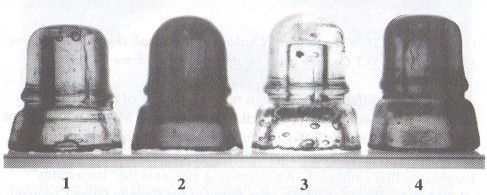 |
1 - Chubby Dome - Dome circumference approx. 19.5 centimeters
2 - Pointed
Dome
3 - Round Dome
4 - Narrow Dome - Dome circumference approx. 18.5
centimeters
5 - Tall Crude |
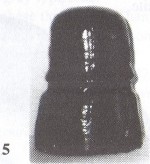 |
There are wide variations in skirt height, especially in the narrow dome variety. Base to wire groove measurements range from 3/4" to almost
2". A chubby dome with a tall skirt is seldom seen, and shorter skirts are
the rule in the pointed and round dome styles. Almost all CD 742s have a smooth
beveled base, the one exception I've seen being a recently unearthed D.T. Co.
with a rounded base similar to the ones found on beehive threadless.
The tall,
crude variant has a narrow dome, but its unique qualities are a less defined
wire groove and ridge. Often these tall early pieces are "leaners."
The glass is often bubbly, creased and roughly formed. This tall variant also
has the widest color range.
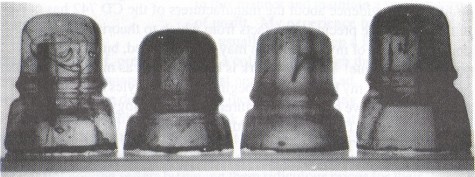
(Left to right) CD 742 variations: Chubby dome with tall skirt; Chubby dome
with short skirt; D.T.Co. with a narrow dome; Narrow dome with a tall skirt.
These differences in design reflect a variety of manufacturers and eras.
Embossings differ as well. There are five M.T. Co. variations pictured along
with the D.T.Co. Embossed and unembossed specimens are found in all mold styles,
although in my experience, the round dome is toughest to find embossed. An
interesting variant is the "backwards" . .T.M style, shards of which
were found at the Canada Glass Company site. .T.M style, shards of which
were found at the Canada Glass Company site.
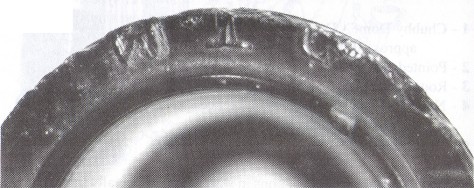
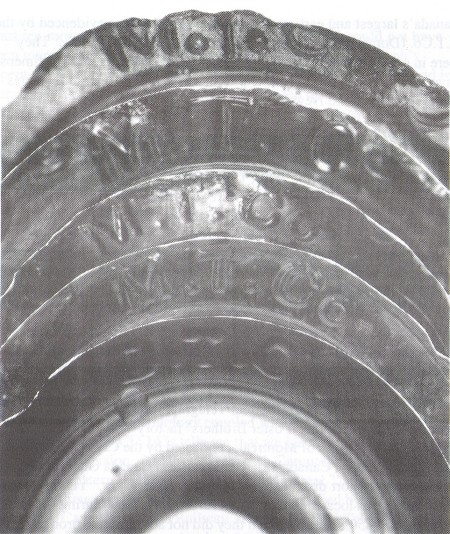
The CD 742 has a fantastic color range. Most are a pale to light blue aqua,
but some specimens have been found in exotic colors like cornflower blue, light
and dark cobalt, several purple shades, teal and emerald greens, jade milk and
an electric, Hemingray-type blue.
Very little is known about the origins of
these threadless. Thanks to Jack Hayes, we do know for certain that Canada Glass
Co., (Hudson, Quebec 1864 - 1877) and Hamilton Glass (Hamilton, Ontario 1865 -
1895) manufactured insulators of this design because shards of CD 742s were
dug at both sites. However, more that two glass houses may have produced these
insulators.
The CD 742 is by far the most often encountered threadless in
Canada. This design was adopted by the Montreal Telegraph Company, Canada's largest and earliest firm, as well as others, as evidenced by the
D.T.Co. (Dominion Telegraph Co.) and unembossed CD 742s. They were in use
extensively in southern Ontario and Quebec, and specimens have been found in the
Maritime provinces as well as the border states -- Maine, Vermont and New York.
So, we know for sure where they were used, but the tough questions are...
where
and when were they made? Many hours of research have yielded few clues, but
thanks to bits of information gleaned from Crown Jewels of the Wire, I can try
to make an educated guess and state my case. I believe they were manufactured
from the early 1860's to the mid-1870's. How did I arrive at this? Here goes....
Montreal Telegraph Company began in 1846 by taking over existing lines as well
as constructing their own new lines. In the 1840's I suspect that Wades and
egg-type (CD 719s) were in use. This is supported by the fact that on lines
where CD 742s are found, Wades and CD 719s often turn up. A letter dated 1861
from George Foster of Foster Brothers, a St. John (Quebec) glass house, refers a
customer to the Montreal Telegraph Company for information on the quality of
insulators he manufactured for them. So we know until the 1860's, Montreal
Telegraph was using some CD 740 type insulators.
Let's assume that Montreal
Telegraph found its sources for insulators close to home. Foster Brothers'
factory was located just 20 miles south of the city of Montreal, connected by
the Champlain and St. Lawrence Railway, Canada's first railroad, and Canada
Glass in Hudson, Quebec was a short distance west on the Ottawa River. Yet
another glass house was located in Como, not far from Hudson, during the late
40's and early 50's, and although they did not advertise the production of
insulators it is possible that they did make them. Perhaps one of these glass
houses on the Ottawa River was the first manufacturer of the CD 742, since
Foster Brothers glass was mostly blackglass -- certainly none of the color and
very few aqua pieces came from the St. John glass house. Since Canada Glass in
Hudson folded in 1865, it made the CD 742 for only a few years, leaving Hamilton
glass, a much bigger company, as a likely source for insulators. Hamilton's
glass was mostly aqua colored, as evidenced by other products (fruit jars,
bottles, etc.) and of course was a result of standardization. A quality oriented
firm, Montreal Telegraph was at the vanguard of technology in line construction
and materials. The CD 742 was a very finished insulator, incorporating a skirt
designed to shed water better than the CD 740 and egg styles.
Although Cauvet's
patent for threads appeared in the U.S. in 1865, the production and/or use of
threadless insulators continued for at least ten more years in Canada. The D.T. Co. CD 742 could not have been
manufactured before 1870, the year of Dominion Telegraph's inception, so we know
for certain that a threadless was manufactured in Canada five years after the
invention of threaded insulators, Also, the McMicking is dated "75" --
although I suspect it was made in the U.S., it was certainly ordered as a
threadless in the mid-1870's. The Dominion Government Telegraph line, Canada's
first cross-country telegraph that reached the western frontier, was completed
in 1876 and was insulated with threadless Baby Battlefords replaced by heavy,
threaded porcelain Gisborne pattern insulators. We also have to allow some years
for the CD 743 "beehive" threadless, which I believe to be the last
threadless design produced in Canada, indeed a design which endured as the
standard railway telegraph insulator for many years -- the threaded CD 143. I feel
that the CD 743 was strictly used as a replacement item on the many existing
threadless lines during the period when new threaded lines were under
construction.
So.... now that I've worked so hard to convince you that threadless insulators were manufactured and used in Canada until the late 1870's, I'll try
to prove that Montreal Telegraph Company was using threaded CD 143's by that same
time! Montreal Telegraph's desire to be on the cutting edge of technology
coupled with the vast numbers of Montreal Telegraph CD 143s tells me that we
have to allow for several years of its production. Montreal Telegraph Company
was absorbed by Great Northwestern in 1881. The fact that Montreal Telegraph CD
143s were discontinued in the early 1880's is further verified by the telegraph
lines of the Canadian Pacific Railway, where Montreal Telegraph CD 143s are
found to the western border of Ontario, but not encountered in the western
provinces. (The Canadian Pacific was completed in 1883).
The time period in
which I've reckoned the CD 742s were produced also coincides with Montreal
Telegraph's most expansive development. This accounts for the vast numbers of CD
742s that have been and will continue to be located. I believe that the earlier
CD 742s (tall skirts, narrow dome) had much more color variance, and the later
squat, chubby domes (almost always found in aqua) reflect the later
standardization which took place in glass house manufacturing.
Dated photographs
are invaluable tools for this type of research. In my studies, the earliest
photograph in which I can identify CD 742s in 1866. If you have found any
earlier photos with CD 742s clearly shown, please let me know -- only additional
facts can clear up the speculation!

|
